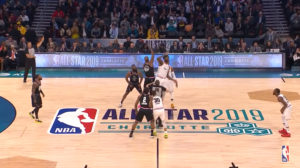 Basketball, at its core, seems straightforward enough – put the ball through the hoop more times than your opponent. But the strategies devised to achieve that simple goal have changed dramatically over the years.
Basketball, at its core, seems straightforward enough – put the ball through the hoop more times than your opponent. But the strategies devised to achieve that simple goal have changed dramatically over the years.
From the early days of rigid formations to today’s fluid and analytics-driven styles, the NBA is a constantly evolving showcase of innovation.
Let’s dive into how the pursuit of championships has shaped the way the game is played.
The Early Days: Set Plays and Static Offenses
In the NBA’s formative years, offenses were highly structured. Coaches meticulously designed set plays, dictating every player’s movement.
The focus was on individual skill, with stars like George Mikan dominating through post-ups and Bob Cousy dazzling with his ball-handling. Defenses were largely man-to-man, making it tougher to break down a well-drilled system.
The Rise of the Big Man and Defensive Dominance
While the fast break was exciting fans, another basketball evolution was taking place. The league gradually saw a rise in the importance of dominant big men. With towering figures like Bill Russell, Wilt Chamberlain, and Kareem Abdul-Jabbar anchoring their teams, defensive strategies became paramount.
Teams such as the Bad Boy era Detroit Pistons gained notoriety with their intensely physical defense, designed to disrupt an opponent’s flow. Zone defenses, once rare, became more common, aiming to clog the paint and protect these shot-blocking giants.
The Rise of Fast Breaks and Showtime Basketball
The 1960s saw a shift towards pace. Teams like the Boston Celtics, led by Bill Russell, emphasized rebounding and sparking fast breaks. This opened up the floor for dynamic scorers like Wilt Chamberlain and Oscar Robertson.
In the 1980s, the Los Angeles Lakers took this up-tempo approach to its zenith with their “Showtime” era, where Magic Johnson’s no-look passes fueled a thrilling brand of basketball.
Individual Brilliance and Isolation Play
The 1980s not only brought electrifying fast breaks but also a resurgence of individual brilliance. Players like Larry Bird, Magic Johnson, and Michael Jordan possessed an uncanny ability to create their own shots.
This often led to isolation plays—clearing out space for a star scorer to go one-on-one against their defender. This style of play sometimes slowed the game’s pace, but the sheer shot-making ability of these legends captivated audiences worldwide.
The Rise of International Influence
The NBA’s growing global appeal in the 1990s and 2000s brought an influx of international talent, further diversifying the league’s strategic landscape. European stars like Dirk Nowitzki and Pau Gasol introduced a finesse-oriented style, emphasizing ball movement, pick-and-pop action, and their signature shot – Nowitzki’s iconic fadeaway. Hakeem Olajuwon, who hails from Nigeria, brought his extraordinary footwork and post moves to the league, inspiring a generation of big men.
This international wave didn’t just impact offensive tactics. Defensive stalwarts like Andrei Kirilenko (Russia) and Dikembe Mutombo (Democratic Republic of Congo) brought length and shot-blocking prowess, forcing teams to adjust their scoring strategies around the rim.
The Jordan Era and Triangle Offense Dominance
While fast breaks became a staple, the 1990s were marked by a return to more structured half-court offenses. The Chicago Bulls, guided by Phil Jackson’s triangle offense, utilized Michael Jordan’s unmatched isolation scoring ability. This system emphasized spacing, ball movement, and reading the defense, leading to six NBA titles for Jordan and the Bulls.
Analytics Revolution and the Three-Point Boom
The early 21st century witnessed the explosion of data-driven basketball. Teams like the Houston Rockets, under general manager Daryl Morey, embraced the three-pointer’s value far more than their contemporaries.
This analytical approach prioritized shot selection based on efficiency, leading to a league-wide increase in three-point attempts. Stephen Curry and the Golden State Warriors took this strategy to the extreme, shattering three-point shooting records and revolutionizing offensive spacing.
Positionless Basketball and the Modern NBA
Today’s game has blurred the lines between traditional positions. Players are expected to be versatile, capable of handling the ball, shooting from outside, and defending multiple positions. Teams like the Milwaukee Bucks, powered by Giannis Antetokounmpo’s unique skillset, embody this shift.
This fluidity makes offenses more unpredictable, with constant switching on defense forcing opponents to adapt on the fly. Fans interested in the latest Mavericks NBA odds are likely seeing how coaches adapt to new rules which continue to make the sport more dynamic.
Conclusion
The evolution of NBA team strategies is a thrilling microcosm of the enduring appeal of basketball. It’s a continuous cycle of innovation, adaptation, and the relentless search for a winning edge. From the methodical plays of the early days to the positionless fluidity of today, the game constantly challenges players, coaches, and fans to think in new ways.
As basketball’s global reach continues to expand, and data analysis becomes ever more sophisticated, the possibilities seem limitless. What strategies will shape the next era? Will we see entirely new offensive systems or mind-bending defensive tactics?
One thing’s for sure: the quest to outsmart and outplay opponents will continue to drive the NBA forward, providing us with countless moments of brilliance and strategic ingenuity for years to come.


